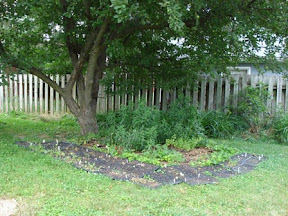Winter of 2005 - 2006 I winter-sowed a lot of forb seeds in flats and got a good germination rate. Some the transplants died during the summer heat but I have quite a few in pots to plant out this spring. I did a lot more this past winter and have about 80 flats of seedlings. I'm not sure when the optimal time to plant will be. Here's the shelter I set up for the seedlings. It's made from the supports that used to be part of raised beds, 1/2 inch pvc pipe form the hoops. It was covered with plastic sheeting this winter and I've replaced that with shade cloth. I've got to work on the design. It is somewhat flattened on the top and that let snow and water accumulate and squash it. I left the plastic on too long and I think some seedlings fried. Either that or the cats squashed them since they decided it made a great place for naps.

For grasses I plan to start with three that are native to this area and supposed to be suitable for the soil and moisture. I don't want the very tallest ones so I have chosen Little bluestem (Schizachyrium scoparium), Prairie dropseed (Sporobolus heterolepsis) and Bottlebrush (Elymus hystrix/Hystrix patula).
In 2006 I laid out a teardrop shaped area that covers approximately 1000 square feet on the left side of the backyard. This is zone 6, full sun, mesic in spring to dry in summer. It's Virginia clay soil and a neighbor enlightened me to why I was hitting a near impenetrable layer about 8 inches down in places – an old railway bed ran through there years back.
I killed the grass with glyphosate herbicide and have repeated applications every month or so. Used a
broadfork to break up the soil to about 12 inches.

It has received most of last year's compost and fresh yard waste. By happy chance our town changed trash pickup rules and my neighbors brought me grass clippings all season. It looks like I have a good 4 or 5 inches of compost now that it has wintered over. I will need to do a couple of applications of herbicide this spring before I plant. I have some awful perennial weeds to get under control.
I'll plant out all the potted plants and seedling plugs, probably in June. In the fall I will direct sow more grass and wildflower seeds and see what comes up in the spring. I understand it takes about 3 years for it to look like much.
Here are the seedlings in the nursery, aka The Pot Ghetto



















